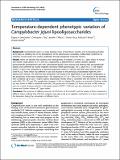| dc.contributor.author | Moran, Anthony P. | en |
| dc.date.accessioned | 2011-05-23T09:33:40Z | en |
| dc.date.available | 2011-05-23T09:33:40Z | en |
| dc.date.issued | 2010-11 | en |
| dc.identifier.citation | Semchenko, E., Day, C., Wilson, J., Grice, I. D., Moran, A., & Korolik, V. (2010). Temperature-dependent phenotypic variation of Campylobacter jejuni lipooligosaccharides. BMC Microbiology, 10(1), 305. | en |
| dc.identifier.uri | http://hdl.handle.net/10379/1925 | en |
| dc.description.abstract | Background:Campylobacter jejuni is a major bacterial cause of food-borne enteritis, and its lipooligosaccharide (LOS) plays an initiating role in the development of the autoimmune neuropathy, Guillain-Barré syndrome, by induction of anti-neural cross-reactive antibodies through ganglioside molecular mimicry.
Results: Herein we describe the existence and heterogeneity of multiple LOS forms in C. jejuni strains of human and chicken origin grown at 37°C and 42°C, respectively, as determined on sodium dodecyl sulphate-polyacrylamide electrophoresis gels with carbohydrate-specific silver staining and blotting with anti-ganglioside ligands, and confirmed by nuclear magnetic resonance (NMR) spectroscopy. The C. jejuni NCTC 11168 original isolate (11168-O) was compared to its genome-sequenced variant (11168-GS), and both were found to have a lower-Mr LOS form, which was different in size and structure to the previously characterized higher-Mr form bearing GM1 mimicry. The lower-Mr form production was found to be dependent on the growth temperature as the production of this form increased from ~5%, observed at 37°C to ~35% at 42°C. The structure of the lower-Mr form contained a ¿-D-Gal-(1¿3)-¿-D-GalNAc disaccharide moiety which is consistent with the termini of the GM1, asialo-GM1, GD1, GT1 and GQ1 gangliosides, however, it did not display GM1 mimicry as assessed in blotting studies but was shown in NMR to resemble asialo-GM1. The production of multiple LOS forms and lack of GM1 mimicry was not a result of phase variation in the genes tested of NCTC 11168 and was also observed in most of the human and chicken isolates of C. jejuni tested.
Conclusion:The presence of differing amounts of LOS forms at 37 and 42°C, and the variety of forms observed in different strains, indicate that LOS form variation may play a role in an adaptive mechanism or a stress response of the bacterium during the colonization of different hosts. | en |
| dc.format | application/pdf | en |
| dc.language.iso | en | en |
| dc.rights | Attribution-NonCommercial-NoDerivs 3.0 Ireland | |
| dc.rights.uri | https://creativecommons.org/licenses/by-nc-nd/3.0/ie/ | |
| dc.subject | Microbiology | en |
| dc.title | Temperature-dependent phenotypic variation of Campylobacter jejuni lipooligosaccharides | en |
| dc.type | Article | en |
| dc.description.peer-reviewed | peer-reviewed | en |
| nui.item.downloads | 257 | |


